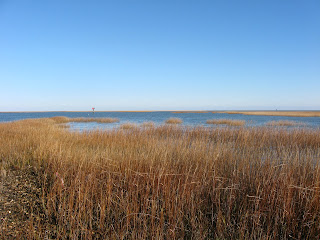 |
| Sue and Sally (her mom) at the height of the storm. |
By Wednesday of last week, the meteorologists were hinting at a significant low pressure system to affect the Southeast by Christmas. Right before Sue and I hopped in the car to go to her parents' place on the Eastern Shore of Virginia, I staked up the wire cages around the little fig tree and our gardenia, filled them with dead leaves to ward off the frost and bid them good luck. The forecast was calling for scattered snow showers starting Saturday afternoon. It was wrong.
The day before Christmas, Sue and I did some birdwatching on the ocean side of the peninsula. During my time as an itinerant field biologist, I spent several falls and one spring on the Delmarva. After Sue and I met and she decided my company was tolerable, she joined me for a field season at Kiptopeke State Park, where I was trapping and banding migrating raptors for the Coastal Virginia Wildlife Observatory. She signed on as the official migration counter and, in addition to falling in love with one another, we fell in love with the Eastern Shore that autumn. It's a very roundabout way of explaining to you that we knew where the hell we were going.
I was hoping to see waterfowl and raptors, as the Blue Ridge Mountains are lacking in both departments. At the tiny fishing village of Oyster, we hit the tides wrong so the mudflats in the creek were underwater.
 |
| common loon (non-breeding plumage) |
We took our time driving up the seaside on Hwy 600 - a rural route that wends its way gracefully across the rather ungraceful dichotomy of culture on the Eastern Shore. It's hard to imagine a place where the rich whites and poor blacks live in such close proximity, yet live such distant versions of the human experience. It is a beautiful place though and, much like when we left it for professional opportunities elsewhere, the Delmarva is still a haven for birds in winter.
Along our way, we stopped to admire a male northern harrier coursing over a harvested cornfield. Red-tailed hawks seemed to be everywhere, along with a few red-shouldereds and an immature Cooper's hawk speeding across open ground, just a foot off the deck as it hoped to take some unsuspecting songbird by surprise.
 |
| Atlantic brant |
All in all, it was a very satisfying afternoon of birding for a couple of coastal hearts. Lucky for us, we went before the now infamous storm of the season slammed the East Coast late Christmas Day and took a full 24 hours to pull out.
By noon we were looking at 8 inches on the back deck. Sue's mom, Sally, couldn't keep the feeders filled for all of the blackbirds pillaging the seeds through the middle of the blizzard.
The common grackles, red-winged blackbirds and brown-headed cowbirds monopolized the feeders in the yard, leaving a tiny, suction-cupped window feeder for everyone else. Turns out, American goldfinches are pretty tough customers once they take a stool at the bar - much to the delight of the cats.
By the time it was all over, the house on Church's Creek had 14 inches of snow. When I called back to Asheville, my parents had measured 10 inches in the back yard. So much for escaping winter's icy grip. I have to admit though, with no place to go and the roads unnavigable, it's been awfully nice to hang around in pajamas, making turkey soup and doing puzzles for the last two days.
Hope your holidays were exactly the way you wanted them. I know mine were.


















